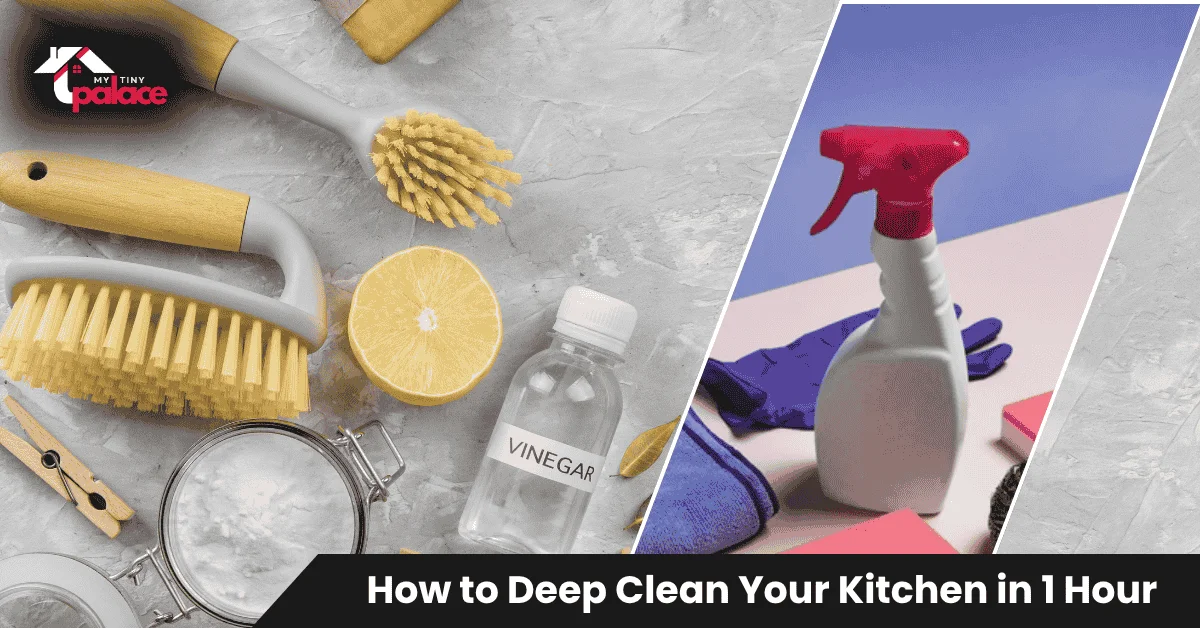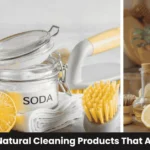Eco-Friendly Cleaning Hacks That Actually WorkA spotless kitchen doesn’t require an entire weekend. You can transform your cooking space from grimy to gleaming in just 60 minutes with the right plan and tools. This guide shows you exactly how to Deep Clean Your Kitchen in 1 Hour, using a time-blocked approach that targets high-impact areas first.
- Quick summary
- How to Deep Clean Your Kitchen in 1 Hour
- Why a timed deep clean matters
- Core tools, cleaners, and safety basics
- The 1-hour plan: step-by-step (priority-based)
- Appliance quick-fixes (oven, microwave, fridge)
- Costs, time, and supplies table
- Common mistakes, safety tips, and what to skip
- Quick maintenance plan to keep results longer
- Quick summary + CTA
Quick summary
One focused hour gives you a clean kitchen and less stress. This method prioritizes visible surfaces and appliances, uses time-saving techniques, and delivers noticeable results without the overwhelm of marathon cleaning sessions.
How to Deep Clean Your Kitchen in 1 Hour
A true one-hour kitchen deep clean focuses on surfaces you see and touch daily. You’ll scrub counters, degrease appliances, sanitize the sink, wipe cabinets, and mop floors. This isn’t a renovation-level overhaul where you pull out the refrigerator or clean behind the stove. Instead, you’re creating a hygienic, presentable space that looks refreshed and feels clean.
The secret lies in smart prioritization. You tackle grease buildup on the range hood before dusting baseboards. You disinfect surfaces that touch food before polishing cabinet doors. This approach maximizes visible impact within your time limit.
Expect your kitchen to smell fresh, look brighter, and feel more inviting after 60 minutes. Sticky counters become smooth. Greasy stovetops shine. Crumb-filled corners disappear. The results won’t match a professional deep clean service, but they’ll dramatically improve your daily cooking environment without eating up your entire day.
Why a timed deep clean matters
Setting a 60-minute timer transforms cleaning from an endless chore into a manageable sprint. You stay focused because you know exactly when you’ll finish. This prevents the common trap of starting to clean and losing three hours to perfectionism.
A regular one-hour deep clean prevents the buildup that leads to bigger problems. Grease accumulation attracts pests. Moisture in cracks grows mold. Food residue harbors bacteria. When you tackle these issues weekly or biweekly with quick, intensive cleaning sessions, you avoid the need for exhausting all-day scrubbing marathons.
Timed cleaning also reduces stress before guests arrive. Instead of panicking about your messy kitchen, you know you can make it presentable in one hour. This confidence matters whether you’re hosting dinner, showing your rental to a landlord, or simply want to enjoy cooking in a clean space.
The psychological benefit is real, too. Finishing a full kitchen clean in 60 minutes gives you a sense of accomplishment. You see immediate results from focused effort. This positive reinforcement makes you more likely to maintain regular cleaning habits instead of avoiding the kitchen until things get truly gross.
Core tools, cleaners, and safety basics

Gather everything before you start the clock. You’ll need a multi-surface cleaner for counters and tables, a degreaser for stovetops and range hoods, and a disinfectant for sinks and cutting boards. White vinegar mixed with water (1:1 ratio) works as a budget-friendly all-purpose cleaner. Baking soda acts as a gentle abrasive for stuck-on grime.
Keep microfiber cloths handy—they lift grease without scratching. You’ll want at least three: one for degreasing, one for general wiping, and one for drying. Add a scrub brush or magic eraser for stubborn spots. A mop or reusable floor wipes handle the final floor sweep.
Wear gloves to protect your hands from harsh chemicals and hot water. Open windows or turn on ventilation fans to keep air circulating. Never mix bleach with ammonia-based cleaners—this combination creates toxic fumes that can harm your lungs. Read product labels and follow dilution instructions to avoid damaging surfaces.
Unplug small appliances before cleaning them. Never spray water directly onto electrical components. If you’re cleaning inside your oven or behind heavy appliances, check manufacturer guidelines first. Some finishes scratch easily with abrasive cleaners, and certain self-cleaning features have specific requirements.
Test new cleaners on a small, hidden spot first. This prevents damage to expensive countertops or cabinet finishes. Store all cleaning products in a cool, dry place away from children and pets.
The 1-hour plan: step-by-step (priority-based)
The key to Deep Cleaning Your Kitchen in 1 Hour success is working in priority order. Start with visible, high-impact areas and move systematically through the space. This plan gives you two options depending on your time.
30-minute express (if you’re short on time)
When you only have half an hour, focus on the most visible spots. Clear and wipe all counters first—this creates instant visual impact. Scrub the sink and faucet until they shine. Wipe down the stovetop and front of appliances to remove fingerprints and grease. Sweep or vacuum the floor quickly, focusing on main traffic areas. Take out the trash and replace the liner to eliminate odors. This express version won’t deep clean everything, but it makes your kitchen look and smell significantly better.
Full 60-minute flow
Minutes 0-10: Prep and declutter. Set your timer and gather all supplies in one spot. Clear counters completely—put away dishes, mail, and random items. This empty surface gives you room to work fast. Fill your sink with hot soapy water and drop in dish brushes, sponges, and removable stove parts to soak while you tackle other areas.
Minutes 10-30: High-impact surfaces and appliances. Start by decluttering counters—clear space saves time. Spray degreaser on the range hood, stovetop, and backsplash. Let it sit for two minutes while you wipe cabinet fronts, starting from the top and working down. Return to the stovetop and scrub away softened grease. Use a degreaser on the range hood before wiping cabinets to maximize your cleaning solution’s effectiveness.
Clean the microwave using the steam-clean method: bowl of water, 3 minutes on high, then wipe clean with a microfiber cloth. The steam loosens stuck food so you can wipe it away in seconds. Wipe the exterior of your refrigerator, removing fingerprints and spills. Check the sink—scrub it thoroughly with a disinfectant and rinse clean.
Minutes 30-50: Counters, cabinets, and floor. Or spray multi-surface cleaner on all counters and let it sit briefly. Wipe down cabinet doors and handles, paying attention to areas near the stove where grease accumulates. Return to counters and scrub any stuck spots with baking soda paste. Disinfect cutting boards and frequently touched surfaces like light switches.
Sweep or vacuum the entire floor, getting into corners and under the table. Mop with your preferred cleaner, starting from the far corner and working toward the exit. If you rent, avoid harsh adhesives and hard fixes that might damage surfaces.
Minutes 50-60: Final touches and quick inspections. Empty crumbs and wipe the sink first for a visible impact—a clean sink makes the whole kitchen feel cleaner. Wipe down small appliances like the toaster and coffee maker. Replace kitchen towels with fresh ones. Take out the trash and put in a new liner. Do a final walk-through, hitting any missed spots. Measure time by checking your progress—if you’re running over, skip the baseboards and save them for next time.
Appliance quick-fixes (oven, microwave, fridge)
Your oven needs the longest treatment. If it has a self-clean function, run it according to manufacturer instructions—but know this takes 2-3 hours, not part of your 60-minute plan. For quick oven cleaning, spray the interior with oven cleaner, let it soak for 10 minutes while you work on other tasks, then wipe clean. Remove racks and soak them in hot, soapy water separately.
The microwave steam-clean trick works every time: fill a microwave-safe bowl with one cup of water and add lemon slices or vinegar. Microwave on high for three minutes. Don’t open the door immediately—let the steam continue working for another minute. Then wipe the interior clean with a cloth. Stuck food practically falls off.
For the fridge, remove expired items first. Wipe shelves with a mild cleaner or vinegar solution. Check door seals for gunk and crumbs. Place an open box of baking soda inside to absorb odors. Don’t move the entire fridge or defrost the freezer during your one-hour session—those are separate projects.
If you rent, stick to gentle cleaners that won’t damage appliance finishes. Never use abrasive scrubbers on stainless steel or glass cooktops. Test cleaners on a small spot before applying widely to avoid permanent damage that could cost you your security deposit.
Costs, time, and supplies table
| Supply Type | Basic Cost | Upgraded Cost | Prep Time |
|---|---|---|---|
| Multi-surface cleaner | $3-5 | $8-12 | 0 min |
| Degreaser | $4-6 | $10-15 | 0 min |
| Microfiber cloths (3-pack) | $5-8 | $15-20 | 0 min |
| Scrub brush/sponges | $3-5 | $8-12 | 0 min |
| Mop/floor wipes | $8-15 | $25-40 | 2 min |
| Gloves and small items | $3-5 | $8-12 | 0 min |
| Total | $26-44 | $74-111 | 2 min |
You can save money by making your own cleaners. White vinegar costs about $3 per gallon and handles most kitchen cleaning tasks when diluted with water. Baking soda ($2 per box) works as both a gentle abrasive and odor eliminator. Dish soap mixed with warm water cleans most surfaces effectively. Basic supplies give you excellent results—upgraded products mainly offer convenience and pleasant scents. For more budget-friendly and environmentally safe cleaning solutions, explore our Eco-Friendly Cleaning Hacks guide.
Common mistakes, safety tips, and what to skip
The biggest mistake is mixing cleaners. Don’t mix bleach with ammonia—that creates toxic fumes that can seriously harm your lungs. Don’t combine vinegar with bleach either. When in doubt, rinse surfaces completely before switching products.
Over-scrubbing damages finishes. Granite counters are scratched by abrasive pads. Stainless steel gets permanent marks from harsh brushes. Always start with the gentlest cleaning method and increase intensity only if needed.
Spraying water near electrical outlets or directly onto appliance controls creates shock hazards. Unplug small appliances before cleaning them. Never stick metal scrubbers into toaster slots or garbage disposal units.
If you’re running out of time, skip these lower-priority items: wiping inside cabinets, cleaning the top of the refrigerator, scrubbing grout lines, washing windows, organizing the pantry, or detailing baseboards. These tasks improve your kitchen but don’t impact hygiene or visible cleanliness as much as counters, sinks, and floors.
Quick maintenance plan to keep results longer
Daily habits prevent major buildup. Wipe counters and the stovetop after cooking. Empty the sink before bed—standing water attracts pests and creates odors. Put away dishes instead of letting them pile up. These two-minute tasks keep your kitchen baseline clean.
Weekly quick maintenance extends your Deep Clean Your Kitchen in 1 Hour results. Wipe cabinet fronts once a week, focusing on areas near the stove. Run a damp mop over the floor on trash day. Clean out the fridge before grocery shopping. These small efforts mean your next deep clean stays easy instead of becoming overwhelming.
Monthly touch-ups catch problems early. Check under the sink for leaks. Wipe down the range hood filter. Clean the microwave thoroughly. Degrease the backsplash if you cook often. This rhythm keeps your kitchen consistently clean without requiring frequent hour-long sessions. For a complete breakdown of daily, weekly, and monthly cleaning tasks throughout your entire home, check out our Ultimate Cleaning Schedule for Every Home.
Quick summary + CTA
You now have a complete plan to Deep Clean Your Kitchen in 1 Hour using prioritized, time-blocked steps. The method works because it focuses on high-impact visible areas first and uses efficient techniques like steam-cleaning and strategic soaking. Pick a day this week, gather your basic supplies, set a 60-minute timer, and start. Your clean kitchen is one focused hour away.














